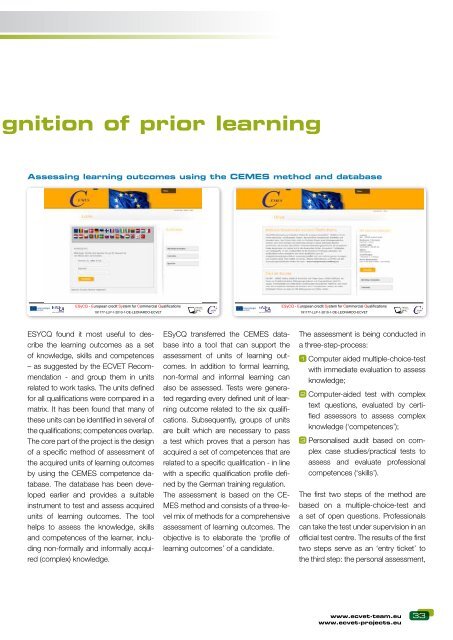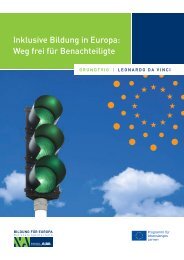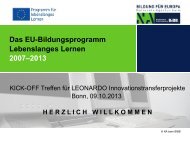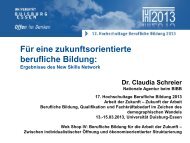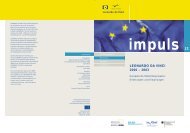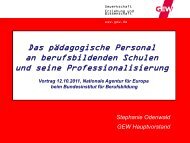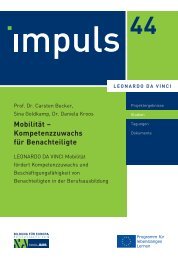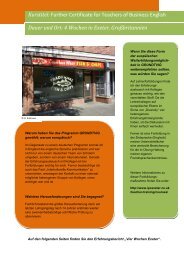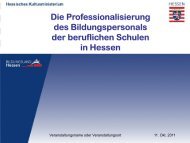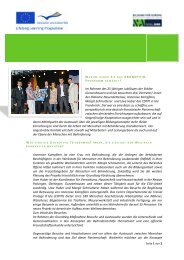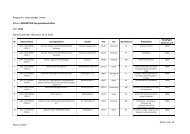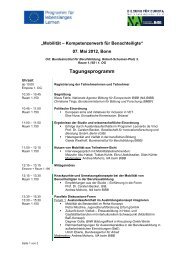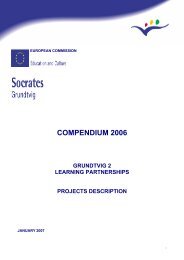Create successful ePaper yourself
Turn your PDF publications into a flip-book with our unique Google optimized e-Paper software.
gnition of prior learning<br />
Assessing learning outcomes using the CEMES method and database<br />
ESyCQ - European credit System for Commercial Qualifications<br />
191177-LLP-1-2010-1-DE-LEONARDO-ECVET<br />
ESYCQ found it most useful to describe<br />
the learning outcomes as a set<br />
of knowledge, skills and competences<br />
– as suggested by the ECVET Recommendation<br />
- and group them in units<br />
related to work tasks. The units defined<br />
for all qualifications were compared in a<br />
matrix. It has been found that many of<br />
these units can be identified in several of<br />
the qualifications; competences overlap.<br />
The core part of the project is the design<br />
of a specific method of assessment of<br />
the acquired units of learning outcomes<br />
by using the CEMES competence database.<br />
The database has been developed<br />
earlier and provides a suitable<br />
instrument to test and assess acquired<br />
units of learning outcomes. The tool<br />
helps to assess the knowledge, skills<br />
and competences of the learner, including<br />
non-formally and informally acquired<br />
(complex) knowledge.<br />
ESyCQ transferred the CEMES database<br />
into a tool that can support the<br />
assessment of units of learning outcomes.<br />
In addition to formal learning,<br />
non-formal and informal learning can<br />
also be assessed. Tests were generated<br />
regarding every defined unit of learning<br />
outcome related to the six qualifications.<br />
Subsequently, groups of units<br />
are built which are necessary to pass<br />
a test which proves that a person has<br />
acquired a set of competences that are<br />
related to a specific qualification - in line<br />
with a specific qualification profile defined<br />
by the German training regulation.<br />
The assessment is based on the CE-<br />
MES method and consists of a three-level<br />
mix of methods for a comprehensive<br />
assessment of learning outcomes. The<br />
objective is to elaborate the ‘profile of<br />
learning outcomes’ of a candidate.<br />
ESyCQ - European credit System for Commercial Qualifications<br />
191177-LLP-1-2010-1-DE-LEONARDO-ECVET<br />
The assessment is being conducted in<br />
a three-step-process:<br />
1 Computer aided multiple-choice-test<br />
with immediate evaluation to assess<br />
knowledge;<br />
2 Computer-aided test with complex<br />
text questions, evaluated by certified<br />
assessors to assess complex<br />
knowledge (‘competences’);<br />
3 Personalised audit based on complex<br />
case studies/practical tests to<br />
assess and evaluate professional<br />
competences (‘skills’).<br />
The first two steps of the method are<br />
based on a multiple-choice-test and<br />
a set of open questions. Professionals<br />
can take the test under supervision in an<br />
official test centre. The results of the first<br />
two steps serve as an ‘entry ticket’ to<br />
the third step: the personal assessment,<br />
<strong>www</strong>.<strong>ecvet</strong>-<strong>team</strong>.<strong>eu</strong> 33<br />
<strong>www</strong>.<strong>ecvet</strong>-projects.<strong>eu</strong>


